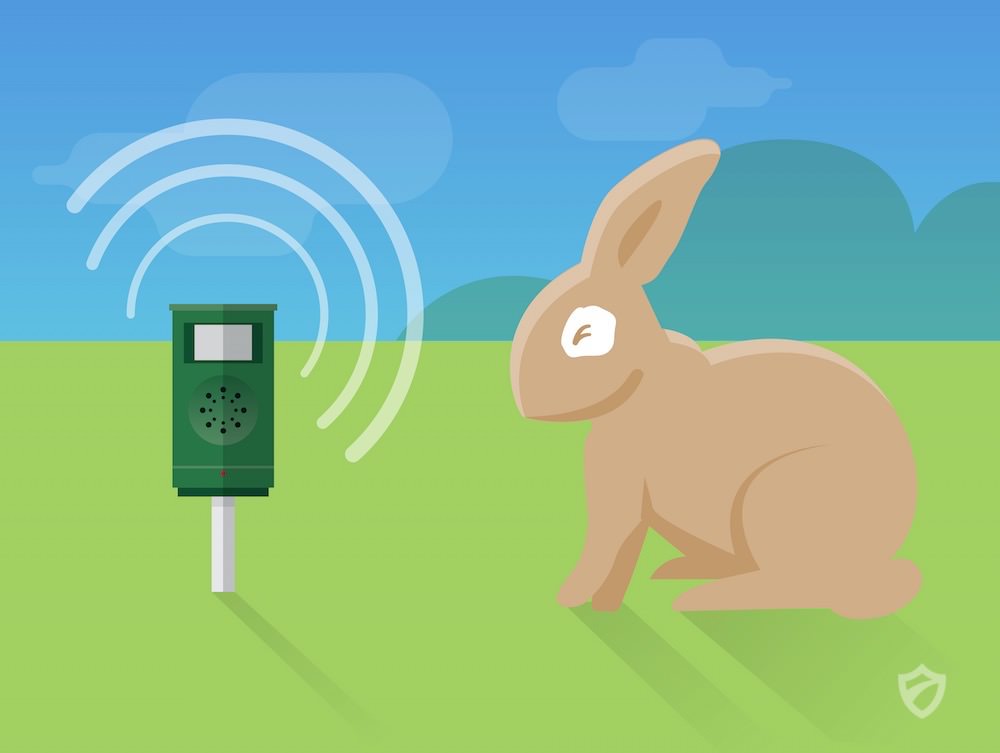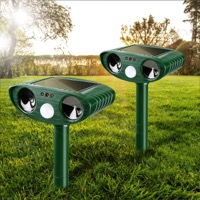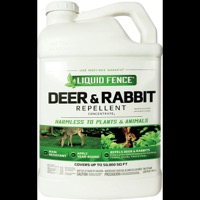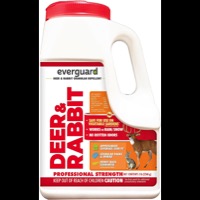Do Ultrasonic Rabbit Repellents Really Work?
An Honest Look

By Sigmund Daughty, Expert Reviewer for Repellent Guide
published: Aug 01, 2023 | updated: Aug 01, 2023
Introduction
In the timeless battle between gardeners and rabbits, many tactics have been employed to safeguard the precious flora that often falls victim to these furry invaders. From traditional methods like fencing and trapping to natural repellents like essential oils, the gardener's arsenal has continuously evolved. Now, as technology permeates even this age-old conflict, ultrasonic repellents are emerging as the new frontier in rabbit deterrence.
Ultrasonic repellents, often hailed as a harmonious blend of technology and nature, promise effectiveness without compromising on ethics. This is a device that doesn't harm or kill the rabbits but instead seeks to establish a boundary that they would naturally avoid. As enchanting as it sounds – a garden filled with invisible barriers of sound that ward off pests – many are left pondering the veracity of such claims. Just how does this method work? And more importantly, does it live up to its promises?
To answer these questions, we must first understand the technology behind it, assess its effectiveness in real-world scenarios, and weigh its pros and cons. So, let's embark on this explorative journey into the world of ultrasonic repellents, cutting through the noise, pun intended, to deliver an informed perspective.
Understanding Ultrasonic Repellents
At its core, an ultrasonic repellent is an embodiment of our growing understanding of animal behavior and technological advancement. These devices work on a simple premise but are backed by complex mechanisms.
Nature of Sound: Sound travels in waves, and the frequency of these waves determines the pitch or tone we hear. While humans can hear frequencies between roughly 20Hz and 20kHz, many animals, including rabbits, have a broader range. 'Ultrasonic' refers to sound frequencies above the human hearing threshold.
How Ultrasonic Repellents Work:

- Emission Mechanism: These devices produce high-frequency sound waves that are typically beyond the range of human hearing but are perceptible to pests like rabbits.
- Distress Signals: The emitted ultrasonic waves are meant to mimic danger signals in the wild or create an environment of auditory discomfort for the pests. Just as a loud construction site might deter humans, these high-frequency sounds are meant to be equally bothersome to rabbits.
- Constant Vigilance: The repellents constantly emit these frequencies, ensuring that the perceived threat for the pests remains persistent. This continuous disturbance discourages rabbits from setting up shop in your garden.
Types and Variations: - Coverage Range: Different models have varying coverage areas. While some are perfect for small gardens or specific zones, others can cover larger expanses. - Frequency Range: Some repellents offer adjustable frequencies, allowing users to target specific pests or a broader range of unwanted visitors. - Power Source: While many models use batteries or standard electric power, there are eco-friendly versions powered by solar energy.
Safety and Interference: A significant advantage of ultrasonic repellents is their safety profile. Since the frequencies are above the human hearing range, there's no noise pollution. However, consideration must be given to pets, as animals like dogs or cats might be sensitive to certain ultrasonic frequencies.
Evaluating the Effectiveness
The crux of the debate surrounding ultrasonic repellents revolves around their efficacy. After all, the primary reason for investing in any repellent is to see results. Let's break down the various perspectives and available research on this topic.
Scientific Research: - Varied Results: Some studies suggest that ultrasonic repellents can be effective in deterring pests, including rabbits. However, other research has shown that the results can be inconsistent, depending on factors like frequency range, habitat, and the particular species being targeted. - Adaptation Over Time: A few studies have indicated that while initial exposure to the ultrasonic waves might deter pests, they can eventually adapt and grow accustomed to the noise. It's akin to how city dwellers become desensitized to the constant hum of urban life.
Field Reports: - Mixed Feedback: Reviews from users are diverse. While some gardeners swear by the effectiveness of these devices, others report minimal to no change in rabbit activity. - Environmental Factors: Effectiveness can be influenced by the surrounding environment. Dense vegetation or barriers can absorb or deflect sound waves, reducing the repellent's efficacy.
Other Factors Influencing Effectiveness: - Placement and Positioning: The placement of the repellent device plays a crucial role. If placed too high or obscured by other objects, its effectiveness can be compromised. - Maintenance: Like any device, maintenance is key. Dust, dirt, or water ingress can affect the device's ability to produce sound waves effectively. - Combining Methods: Some users have found success in pairing ultrasonic repellents with other deterrence methods, creating a multi-faceted defense against pests.
By understanding the varied results and the factors that influence effectiveness, one can make an informed decision about whether ultrasonic repellents are the right choice for their garden or yard.
Potential Drawbacks and Limitations
While ultrasonic repellents can be a promising solution for many gardeners and homeowners, it's essential to recognize that they're not without their limitations. Here are some potential challenges and drawbacks to consider:
1. Adaptation by Pests: - As earlier mentioned, there's evidence to suggest that some pests, including rabbits, might become accustomed to the ultrasonic noise over time. Just as we might get used to a ticking clock or a humming refrigerator, rabbits might learn to ignore or tolerate the sound if exposed for extended periods.
2. Range Limitations: - Ultrasonic waves diminish in strength over distance. Depending on the model and its power, the effective range can vary. Users might need multiple devices to cover a larger area adequately.
3. Physical Barriers: - Ultrasonic waves can't penetrate solid objects or thick vegetation effectively. This means that walls, fences, bushes, and even tall grass can diminish the effectiveness of the repellent. Strategic placement, free from obstructions, is crucial.
4. Weather Factors: - Heavy rain, wind, or snow can interfere with the propagation of ultrasonic waves. While some devices are weather-resistant, their effectiveness might be compromised in extreme weather conditions.
5. Impact on Non-Target Animals: - While the primary objective might be to deter rabbits, ultrasonic waves can affect other wildlife or domestic pets. Especially if one has pets like dogs, cats, or even birds, there's a potential that these animals might be disturbed by the frequencies.
6. Energy Consumption: - While many ultrasonic repellents have low power consumption, they do need a power source to function. Over time, this might lead to additional energy costs, especially for electrically powered units.
7. Reliability Concerns: - Like all electronic devices, ultrasonic repellents can malfunction or wear out. It's essential to invest in a quality device and regularly check its functioning to ensure it's working as intended.
While ultrasonic repellents offer a modern solution to age-old problems, understanding these potential challenges ensures that users can make the most out of their devices and set realistic expectations.
Choosing the Right Ultrasonic Repellent for Your Needs
With numerous ultrasonic repellents available in the market, picking the right one can seem overwhelming. However, by understanding certain factors and considerations, you can make an informed choice that aligns with your specific needs.
1. Coverage Area: - Consider the size of the area you wish to protect. If you have a large garden or yard, you might need a device with a more extensive range or potentially multiple devices to ensure full coverage.
2. Power Source: - Ultrasonic repellents are usually powered either by batteries or directly from the mains. Some even come with solar charging options. Decide which is most convenient for you based on the placement and your ability to change or recharge batteries.
3. Weather Resistance: - If you're placing your device outdoors, it needs to withstand varying weather conditions. Look for repellents that are labeled as water-resistant or weatherproof.
4. Frequency Range: - The frequency range determines which pests the device can repel. Some devices allow users to change frequencies to target specific pests. If rabbits are your primary concern, ensure the repellent is effective for that specific animal.
5. Safety Features: - For households with children or pets, it's essential to choose a device that doesn't pose any safety risks. Check for any exposed wiring, sharp edges, or small parts that might be harmful.
6. Customer Reviews and Feedback: - Often, real-world feedback can offer insights that product descriptions don't. Before making a purchase, read reviews to see how the product has worked for others, especially in contexts similar to yours.
7. Warranty and Support: - A warranty can be an indicator of the manufacturer's confidence in the product. Moreover, good customer support can be invaluable if you face any challenges in setting up or using the device.
8. Aesthetics and Design: - While function is paramount, the design can also be a consideration, especially if the repellent will be placed in visible areas of your garden or yard.
By weighing these factors against your personal needs and preferences, you can find an ultrasonic repellent that's both effective and suitable for your specific situation.
Conclusion: Weighing the Benefits Against the Limitations
Ultrasonic repellents present a modern, humane approach to deterring pests like rabbits from our gardens and homes. While they offer several advantages over traditional methods, such as being chemical-free and non-lethal, it's crucial to approach them with a clear understanding of their limitations.
Remember, no single solution is a silver bullet. The effectiveness of ultrasonic repellents can vary based on several factors, including the specific animal, the device's quality, and the surrounding environment. However, when used strategically and in conjunction with other methods, they can play a pivotal role in keeping unwanted critters at bay.
For homeowners and gardeners who are looking for a humane way to protect their spaces, ultrasonic repellents are undoubtedly worth considering. By pairing the right device with a good understanding of its capabilities, you can enjoy a peaceful, rabbit-free garden without causing harm to the environment or the animals.
I hope this article has provided a comprehensive overview of ultrasonic repellents for rabbits. Remember always to research and choose products wisely, keeping in mind both their advantages and potential drawbacks.
-
Ultrasound
-
Concentrate
-
Granules




